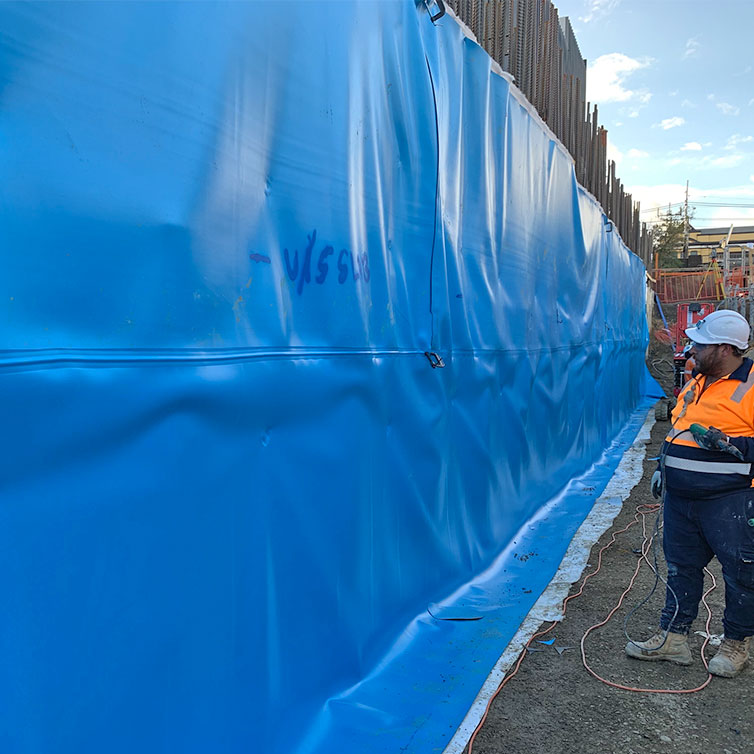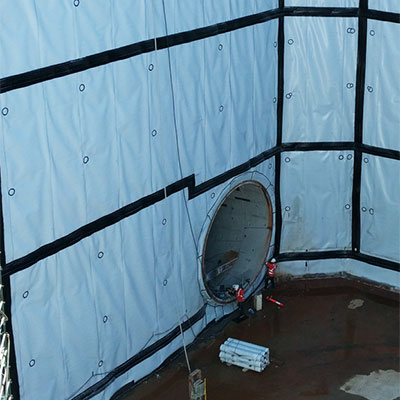Engineering is an important part of the waterproofing process. Bluey employs qualified, full-time engineers that specialise in tunnel waterproofing. This second instalment to our project checklist has been made by them, to ensure that project design consultants understand the strict detailing that is required to work in accordance with World’s best practices.
11) Check for slab buoyancy
During concrete arch pours in tunnels, the formwork can lift due to buoyancy, creating extremely high forces. Bluey will engineer the right size and shape protection pad to protect the membrane in this area, depending on the size and shape of the formwork.
12) Consider the impact of pipes and service penetrations
There is often a need to design pipe and service penetrations to pass through the membrane. These are a common source of leakage if not addressed correctly with an engineered solution. Bluey has custom trumpets to suit a range of pipe penetration diameters.
13) If using a sheet membrane, don’t limit the project to formed concrete
Shotcrete application to sheet membrane has been an international challenge which was solved in Australia some years ago. Bluey, together with some clever project teams, developed a unique system for allowing large-scale application of this method to facilitate high-build and minimum rebound losses.
14) Ensure the liner stays watertight with the use of a protection system
Once the membrane is installed, particularly in the invert, a protection system must be applied. Bluey will evaluate the project circumstances for likely traffic and other factors before recommending the right solution. This may be in the form of blinding concrete or as simple as a recycled membrane layer.
15) Reduce wastage and save on costs
Ordering correct sheet roll lengths is often misjudged or overlooked. This decision is critical to minimising wastage, as the additional roll length results in an off-cut. However, if the rolls are too short, maybe as a result of over-break, then a significant amount of labour is required for an extension. Remember the old saying “measure twice, cut once”. This is a critical decision on any project, which will impact the budget.
16) Use waterstops to compartmentalise the liner
Waterstop spacing is an important detail for minimising risk. Compartmentalisation will limit the spread of leaks if damage occurs to the membrane during the service life. Following international standards for spacing is important. Looping and continuity of the water stop will provide long-term assurance.
17) Select the right geotextile material and weight per square metre
Geotextile and drainage systems are key components of both drained and tanked systems. The geotextile has a two-fold job in protecting the membrane and allowing water to drain and equalise behind it. Did you know that some geotextile material is not suitable for an alkaline environment?
18) Position drainage components to capture all water flows
In a drained tunnel, the detailing of drainage components will lead to the success or failure of the entire system. It is surprising how complex this can be and how often it can be designed incorrectly, resulting in leaks after completion. The kicker in invert drainage placement is the key to a dry pavement.
19) Detailing and effectiveness of various external compartmentalisation systems is not only important to the tunnel user but also to the surrounding communities.
External compartmentalisation needs to be installed where groundwater movements on the outside of the membrane need to be prevented. This can be required to preserve water head around creeks to maintain ecology or, otherwise, around homes to prevent settlement.
20) Correct access equipment is critical to the success of any waterproofing project.
Specialist access equipment can often be required, depending on the project requirements. The right access equipment will allow fast installation and getting the design right will result in installation cost savings. Leaving the design up to the teams doing the installation makes the most sense.
It takes approximately five years to train a waterproofing installation technician. Bluey has established a plastics welding course in conjunction with PARTEC in Queensland, which is an independent, government-funded plastics and composites training college. We have proudly trained many young Australians to successfully work in the tunnel industry. Some of our original team from 2003 remain as Bluey employees, now training others.
Please contact us on 1300 0 BLUEY or at bluey@bluey.com.au if you’d like more tips or additional questions answered.
To read more about Bluey waterproofing and linings, click here: https://www.bluey.com.au/category/waterproofing-linings


